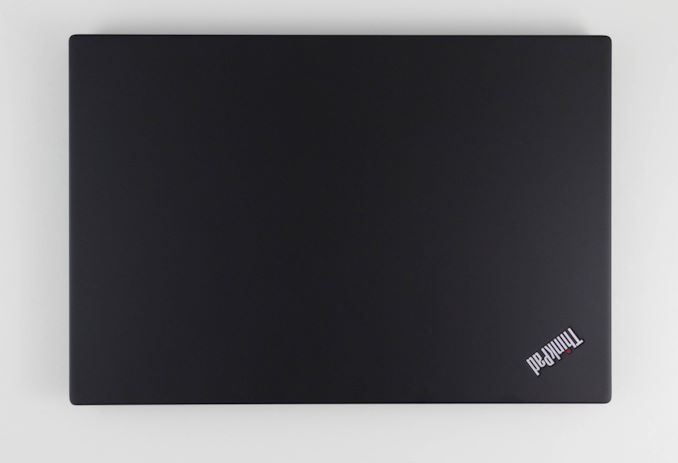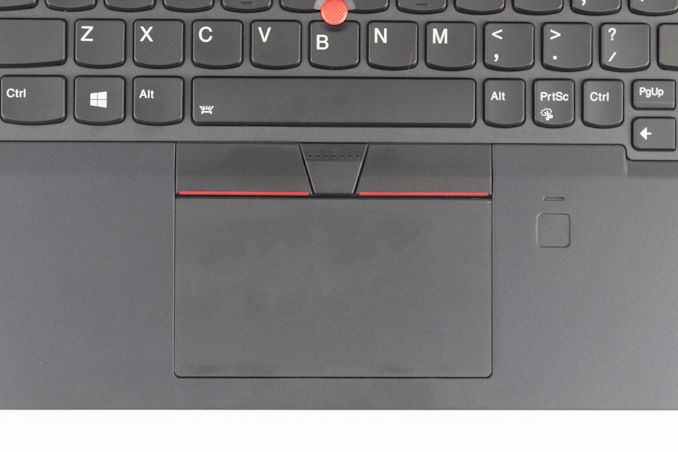The Lenovo ThinkPad A285 (12.5-Inch) Review: Ryzen Pro Gets Down to Business
by Brett Howse on December 18, 2018 8:00 AM EST- Posted in
- Laptops
- AMD
- Lenovo
- ThinkPad
- Vega
- Ryzen
- Ryzen PRO
- Ryzen Mobile
- Vega Mobile
Design
The ThinkPad is an iconic look at this point, and Lenovo has done well to constantly update and refresh the design without losing that ThinkPad look. The matte black is exactly what people expect, along with the red LED dot over the i on the back. The ThinkPad A285 is basically the same chassis as the Lenovo ThinkPad X280, with the same dimensions, same weight, and same strong build.
Despite the 12.5-inch display being smaller than a 13.3-inch model, this model hasn’t gotten the slim bezel treatment yet, so it definitely looks a bit more dated than slimmed down bezels in the ThinkPad X1 Carbon, and therefore the footprint of the 12.5-inch A285 is not quite as small as you may think. Still, it is quite compact, and thin at 17.4 mm where it isn’t going to take up a lot of room in a bag.
Lenovo offers some of the best keyboards around on the ThinkPad lineup, and the A285 offers that same sculpted key feel that they do so well. The keys themselves have good travel, and offer just enough resistance to feel right. The keyboard offers a couple of levels of white backlighting, which contrasts well with the black keys with white letters. Lenovo reverses the Fn and Ctrl keys on all of their ThinkPad keyboards, but that’s only really an issue if you’re coming from a different brand. Luckily if you don’t want to unlearn your muscle memory, you can reverse them in software.
Lenovo utilizes the Microsoft Precision touchpad drivers, and the touchpad, while not as silky smooth as some of its competition, still offers great response, and seems to pick up multiple finger inputs with no issues. For those that prefer the TrackPoint, that is available as well, and would be sorely missed if Lenovo ever decides to do away with it.
The left side offers the two USB-C ports, with one integrated into the docking connection, which also offers the native Ethernet dongle attachment. The USB-A ports are split between both sides, with the right side offering the always-on version. There’s of course a 3.5 mm headset jack, and HDMI on the left. If you order a model with a smart card reader, that would be located on the right. On the rear is a microSD storage expansion slot.
There’s been an unfortunate tendency for AMD’s processors to find their way into value devices, but the ThinkPad A285 breaks that pattern, as it's basically the same chassis as their Intel-based X280, just with different internals. The result is a well-built, premium business device which happens to offer AMD's Ryzen Pro. So IT administrators will love it because it's as classic a ThinkPad as they come, while enthusiasts will be keen to see what AMD can do in a business-grade laptop.















72 Comments
View All Comments
Brett Howse - Tuesday, December 18, 2018 - link
The Surface Book 2 was the device I had power draw numbers from for the idle power draw graph so I have no issues including it in the performance graphs as well. The CPU is a 15W i7. The GPU is of course more powerful but that's still a valid point since people may wonder how close Vega in an iGPU factor is coming to dGPUs.But the best part is that if you don't think it's important, you can just ignore that data point and compare against all the others. Or, click the links I provide to our Online Bench database and make any comparisons you prefer. We provide all the data.
QChronoD - Wednesday, December 19, 2018 - link
I think that many of the people who were complaining about that would accept the comparison if an estimated price of each machine was given at the beginning. If you knew before looking at the graphs that one of the laptops was 2x the price and it looks like being 2x as fast then everything is fine, but if you aren't aware of the price difference then it looks like this machine is a steaming pile.QChronoD - Wednesday, December 19, 2018 - link
Just for reference if anyone actually reads the comments:Microsoft Surface Book 2 15 - $2600
Dell Latitude 13" 2-in-1 7390 - $1800
Asus Zenbook 3 - $1500
Huawei Matebook X Pro - $1350
Lenovo ThinkPad X1 Yoga - $1500
Lenovo ThinkPad A285 - $1200
Microsoft Surface Pro 6 - $1000
Acer Swift 3 R7-2700U - $700
These are just quick prices off amazon trying to get similar specs.
IGTrading - Thursday, December 20, 2018 - link
I agree AnandTech provides "all the data" and that's of course laudable.But often times you can bury a good product in all that data. Comparing a 1200 USD notebook with 2600 USD notebooks is way beyond a stretch.
The potential buyer reading the review for a 1200 USD model is reading it for a reason: because that's what he wants (a 12" portable) or that's his budget (1200 USD) .
Ok ... you compare it with other similar sized notebooks that are also similarly priced ... such as 900 ~ 1400 USD ...
But I honestly have the feeling the results of the Lenovo AMD Ryzen-based notebook are buried in "all the data" ...
Like I've said ... this doesn't look like a review at all and also it doesn't look like a Round-Up (several notebook in a certain price range or with similar characteristics) ..
Going from 700 USD to 2600 USD as a price range ... And from 12" to 15" as a size range ... makes this look like somebody wanted to make the AMD Ryzen portable look slower than a notebook which is much larger and more than 200% more expensive ....
This is how a just comparison should look like in my view (Test Product vs. Similar Products in the Same Product Range vs. 1 product from the Upper Product Range as a comparison example) : https://hothardware.com/ContentImages/Article/2690...
And Ryzen did not beat the CPU+dGPU either ... nor did it ace all the tests ... but I never had the feeling of its results being buried in "all the data" ... just IMHO
kaidenshi - Tuesday, December 18, 2018 - link
Yep, two thin netbooks/ultrabooks I've had in the past had pop-down Ethernet ports, which were the same height as a USB-A port when not in use.thesavvymage - Tuesday, December 18, 2018 - link
honestly though, why do you need an ethernet port on the device? Its kinda just wasting space since its not like you plug that in separately, it should just be connected to whatever dock you have at someone's desk. If I had to plug in power, monitor, and ethernet separately every time I sat at my desk I'd go mad.Right now at work I'm using a macbook and its pretty simple to have all that plugged into a USB-C dock
SaolDan - Wednesday, December 19, 2018 - link
In my line of work i have to be able to connect to lightin controllers and switches thru ethernet out in the field so a Ethernet por would be required.The_Assimilator - Wednesday, December 19, 2018 - link
Not to mention that you have to fork out extra for the dongle!darkich - Tuesday, December 18, 2018 - link
.. a 768p TN entry level screen?Really? My goodness
PeachNCream - Tuesday, December 18, 2018 - link
12.5 inches. At 1080p on that size screen, scaling will be a thing and some software still sucks at scaling. Scaling will also mean that basically the same quantity of information can be displayed at the same time even if the resolution is higher. The GPU will work harder and consume more power while generating more heat to push pixels that do not benefit productivity.